[English] 日本語
 Yorodumi
Yorodumi- PDB-5ide: Cryo-EM structure of GluA2/3 AMPA receptor heterotetramer (model I) -
+ Open data
Open data
- Basic information
Basic information
| Entry | Database: PDB / ID: 5ide | ||||||
|---|---|---|---|---|---|---|---|
| Title | Cryo-EM structure of GluA2/3 AMPA receptor heterotetramer (model I) | ||||||
 Components Components |
| ||||||
 Keywords Keywords | SIGNALING PROTEIN / AMPA glutamate receptor | ||||||
| Function / homology |  Function and homology information Function and homology informationTrafficking of AMPA receptors / Synaptic adhesion-like molecules / spine synapse / dendritic spine neck / dendritic spine head / protein heterotetramerization / cellular response to amine stimulus / perisynaptic space / Activation of AMPA receptors / parallel fiber to Purkinje cell synapse ...Trafficking of AMPA receptors / Synaptic adhesion-like molecules / spine synapse / dendritic spine neck / dendritic spine head / protein heterotetramerization / cellular response to amine stimulus / perisynaptic space / Activation of AMPA receptors / parallel fiber to Purkinje cell synapse / ligand-gated monoatomic cation channel activity / AMPA glutamate receptor activity / response to lithium ion / Trafficking of GluR2-containing AMPA receptors / kainate selective glutamate receptor activity / AMPA glutamate receptor complex / cellular response to glycine / extracellularly glutamate-gated ion channel activity / immunoglobulin binding / asymmetric synapse / ionotropic glutamate receptor complex / conditioned place preference / regulation of receptor recycling / glutamate receptor binding / Unblocking of NMDA receptors, glutamate binding and activation / positive regulation of synaptic transmission / synaptic cleft / regulation of synaptic transmission, glutamatergic / response to fungicide / cytoskeletal protein binding / glutamate-gated receptor activity / regulation of long-term synaptic depression / extracellular ligand-gated monoatomic ion channel activity / cellular response to brain-derived neurotrophic factor stimulus / presynaptic active zone membrane / glutamate-gated calcium ion channel activity / somatodendritic compartment / dendrite membrane / ionotropic glutamate receptor binding / ligand-gated monoatomic ion channel activity involved in regulation of presynaptic membrane potential / ionotropic glutamate receptor signaling pathway / dendrite cytoplasm / synaptic membrane / dendritic shaft / SNARE binding / transmitter-gated monoatomic ion channel activity involved in regulation of postsynaptic membrane potential / synaptic transmission, glutamatergic / PDZ domain binding / protein tetramerization / establishment of protein localization / postsynaptic density membrane / cerebral cortex development / modulation of chemical synaptic transmission / receptor internalization / Schaffer collateral - CA1 synapse / long-term synaptic potentiation / terminal bouton / synaptic vesicle / synaptic vesicle membrane / presynapse / signaling receptor activity / amyloid-beta binding / presynaptic membrane / growth cone / scaffold protein binding / perikaryon / protein homotetramerization / chemical synaptic transmission / dendritic spine / postsynaptic membrane / neuron projection / postsynaptic density / axon / external side of plasma membrane / neuronal cell body / dendrite / synapse / protein kinase binding / protein-containing complex binding / glutamatergic synapse / cell surface / endoplasmic reticulum / protein-containing complex / identical protein binding / membrane / plasma membrane Similarity search - Function | ||||||
| Biological species |  | ||||||
| Method | ELECTRON MICROSCOPY / single particle reconstruction / cryo EM / Resolution: 8.25 Å | ||||||
 Authors Authors | Herguedas, B. / Garcia-Nafria, J. / Fernandez-Leiro, R. / Greger, I.H. | ||||||
 Citation Citation |  Journal: Science / Year: 2016 Journal: Science / Year: 2016Title: Structure and organization of heteromeric AMPA-type glutamate receptors. Authors: Beatriz Herguedas / Javier García-Nafría / Ondrej Cais / Rafael Fernández-Leiro / James Krieger / Hinze Ho / Ingo H Greger /  Abstract: AMPA-type glutamate receptors (AMPARs), which are central mediators of rapid neurotransmission and synaptic plasticity, predominantly exist as heteromers of the subunits GluA1 to GluA4. Here we ...AMPA-type glutamate receptors (AMPARs), which are central mediators of rapid neurotransmission and synaptic plasticity, predominantly exist as heteromers of the subunits GluA1 to GluA4. Here we report the first AMPAR heteromer structures, which deviate substantially from existing GluA2 homomer structures. Crystal structures of the GluA2/3 and GluA2/4 N-terminal domains reveal a novel compact conformation with an alternating arrangement of the four subunits around a central axis. This organization is confirmed by cysteine cross-linking in full-length receptors, and it permitted us to determine the structure of an intact GluA2/3 receptor by cryogenic electron microscopy. Two models in the ligand-free state, at resolutions of 8.25 and 10.3 angstroms, exhibit substantial vertical compression and close associations between domain layers, reminiscent of N-methyl-D-aspartate receptors. Model 1 resembles a resting state and model 2 a desensitized state, thus providing snapshots of gating transitions in the nominal absence of ligand. Our data reveal organizational features of heteromeric AMPARs and provide a framework to decipher AMPAR architecture and signaling. | ||||||
| History |
|
- Structure visualization
Structure visualization
| Movie |
 Movie viewer Movie viewer |
|---|---|
| Structure viewer | Molecule:  Molmil Molmil Jmol/JSmol Jmol/JSmol |
- Downloads & links
Downloads & links
- Download
Download
| PDBx/mmCIF format |  5ide.cif.gz 5ide.cif.gz | 414.2 KB | Display |  PDBx/mmCIF format PDBx/mmCIF format |
|---|---|---|---|---|
| PDB format |  pdb5ide.ent.gz pdb5ide.ent.gz | 254.4 KB | Display |  PDB format PDB format |
| PDBx/mmJSON format |  5ide.json.gz 5ide.json.gz | Tree view |  PDBx/mmJSON format PDBx/mmJSON format | |
| Others |  Other downloads Other downloads |
-Validation report
| Summary document |  5ide_validation.pdf.gz 5ide_validation.pdf.gz | 961.7 KB | Display |  wwPDB validaton report wwPDB validaton report |
|---|---|---|---|---|
| Full document |  5ide_full_validation.pdf.gz 5ide_full_validation.pdf.gz | 963.1 KB | Display | |
| Data in XML |  5ide_validation.xml.gz 5ide_validation.xml.gz | 64.2 KB | Display | |
| Data in CIF |  5ide_validation.cif.gz 5ide_validation.cif.gz | 108.2 KB | Display | |
| Arichive directory |  https://data.pdbj.org/pub/pdb/validation_reports/id/5ide https://data.pdbj.org/pub/pdb/validation_reports/id/5ide ftp://data.pdbj.org/pub/pdb/validation_reports/id/5ide ftp://data.pdbj.org/pub/pdb/validation_reports/id/5ide | HTTPS FTP |
-Related structure data
| Related structure data |  8090MC  8091C  5fwxC  5fwyC  5idfC M: map data used to model this data C: citing same article ( |
|---|---|
| Similar structure data |
- Links
Links
- Assembly
Assembly
| Deposited unit | 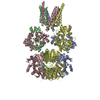
|
|---|---|
| 1 |
|
- Components
Components
| #1: Protein | Mass: 97663.188 Da / Num. of mol.: 2 / Mutation: N292C Source method: isolated from a genetically manipulated source Details: The sequence corresponds to mature rat GluA2 (residues 22-883, isoform Flip, edited at R/G and Q/R sites) with a Myc tag after the first residue and the N292C mutation Source: (gene. exp.)   Homo sapiens (human) / References: UniProt: P19491 Homo sapiens (human) / References: UniProt: P19491#2: Protein | Mass: 99075.664 Da / Num. of mol.: 2 / Mutation: R439G, R265C Source method: isolated from a genetically manipulated source Details: The sequence corresponds to the mature rat GluA3 subunit (residues 23-888, Flip isoform) with a Flag tag after the first residue and mutated at R439G and R265C Source: (gene. exp.)   Homo sapiens (human) / References: UniProt: P19492 Homo sapiens (human) / References: UniProt: P19492 |
|---|
-Experimental details
-Experiment
| Experiment | Method: ELECTRON MICROSCOPY |
|---|---|
| EM experiment | Aggregation state: PARTICLE / 3D reconstruction method: single particle reconstruction |
- Sample preparation
Sample preparation
| Component | Name: AMPA GluA2/3 heterotetramer / Type: COMPLEX Details: Full-length GluA2/3 heterotetramer containing the A2_N292C and A3_265C mutations Entity ID: all / Source: RECOMBINANT |
|---|---|
| Molecular weight | Value: 0.4 MDa / Experimental value: NO |
| Source (natural) | Organism:  |
| Source (recombinant) | Organism:  Homo sapiens (human) / Cell: HEK293 GntI- / Plasmid: prk5 and pIRES2-EGFP Homo sapiens (human) / Cell: HEK293 GntI- / Plasmid: prk5 and pIRES2-EGFP |
| Buffer solution | pH: 7.4 / Details: 25 mM Tris pH 7.4, 0.25 % DDM, 150 mM NaCl |
| Specimen | Conc.: 0.03 mg/ml / Embedding applied: NO / Shadowing applied: NO / Staining applied: NO / Vitrification applied: YES |
| Specimen support | Grid material: COPPER / Grid mesh size: 300 divisions/in. / Grid type: Quantifoil R1.2/1.3 |
| Vitrification | Instrument: FEI VITROBOT MARK IV / Cryogen name: ETHANE / Humidity: 100 % / Chamber temperature: 277 K / Details: Incubated for 1 minute, blotted for 3 seconds |
- Electron microscopy imaging
Electron microscopy imaging
| Experimental equipment |  Model: Titan Krios / Image courtesy: FEI Company |
|---|---|
| Microscopy | Model: FEI TITAN KRIOS |
| Electron gun | Electron source:  FIELD EMISSION GUN / Accelerating voltage: 300 kV / Illumination mode: OTHER FIELD EMISSION GUN / Accelerating voltage: 300 kV / Illumination mode: OTHER |
| Electron lens | Mode: BRIGHT FIELD / Calibrated magnification: 28409 X / Nominal defocus max: 4000 nm / Nominal defocus min: 1000 nm / Cs: 2.7 mm / C2 aperture diameter: 70 µm |
| Specimen holder | Cryogen: NITROGEN / Specimen holder model: FEI TITAN KRIOS AUTOGRID HOLDER |
| Image recording | Average exposure time: 25 sec. / Electron dose: 40 e/Å2 / Detector mode: COUNTING / Film or detector model: GATAN K2 SUMMIT (4k x 4k) / Num. of grids imaged: 2 / Num. of real images: 980 |
| EM imaging optics | Energyfilter name: GIF Quantum / Energyfilter upper: 20 eV / Energyfilter lower: 0 eV |
| Image scans | Movie frames/image: 20 / Used frames/image: 1-20 |
- Processing
Processing
| EM software |
| |||||||||||||||||||||||||||||||||||||||||||||
|---|---|---|---|---|---|---|---|---|---|---|---|---|---|---|---|---|---|---|---|---|---|---|---|---|---|---|---|---|---|---|---|---|---|---|---|---|---|---|---|---|---|---|---|---|---|---|
| CTF correction | Type: PHASE FLIPPING AND AMPLITUDE CORRECTION | |||||||||||||||||||||||||||||||||||||||||||||
| Particle selection | Num. of particles selected: 107939 | |||||||||||||||||||||||||||||||||||||||||||||
| Symmetry | Point symmetry: C1 (asymmetric) | |||||||||||||||||||||||||||||||||||||||||||||
| 3D reconstruction | Resolution: 8.25 Å / Resolution method: FSC 0.143 CUT-OFF / Num. of particles: 25238 / Symmetry type: POINT | |||||||||||||||||||||||||||||||||||||||||||||
| Atomic model building | Protocol: RIGID BODY FIT / Space: REAL Details: For GluA2 chains (A,C), 2 copies of GluA2NTD (3HSY) and two copies of GluA2 LBD (1FTO) were fitted. For GluA3 chains (B,D), 2 copies of GluA3NTD (3O21) and two copies of GluA2 LBD (3UA8) ...Details: For GluA2 chains (A,C), 2 copies of GluA2NTD (3HSY) and two copies of GluA2 LBD (1FTO) were fitted. For GluA3 chains (B,D), 2 copies of GluA3NTD (3O21) and two copies of GluA2 LBD (3UA8) were fitted.For the TMD region, the 4 chains of 3KG2 TMD(residues 509-544 594-629 784-817) were fitted as a rigid body. After fitting the sequence was corrected including mutations and side chains were removed. | |||||||||||||||||||||||||||||||||||||||||||||
| Atomic model building | 3D fitting-ID: 1 / Source name: PDB / Type: experimental model
|
 Movie
Movie Controller
Controller


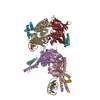

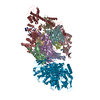
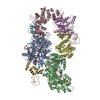


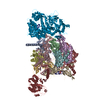
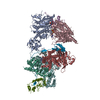
 PDBj
PDBj









